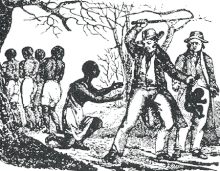History of slavery in Oklahoma
The history of slavery in Oklahoma began in the 1830s with the five Native American nations in the area: Cherokee, Chickasaw, Choctaw, Creek, and Seminole.
[4] With the forced removal of the five nations into the land of Oklahoma throughout the course of time, slavery began and progressed in the Indian territory.
[6] With the Creek Indians, slaves were treated almost as prisoners of war but through time and hard work, could elevate their status in society and become part of the family that owned them.
If a Native woman married an African man, him and their children would be free of servitude, and could rise in the ranks of the community.
Though some pure-blooded Cherokee members held slaves, a majority of slaveholders were of European descent, as they were taught the benefits of slavery from their family.
For decades, these slaves provided labor, relations, and translation to settlers, becoming a part of Indian culture and history.
Tribes became "westernized" as Europeans and American settlers moved through and tribal leaders of mixed race rose to power.
In 2017, a federal court ruling ensured that African Americans who were descendants of those owned by the Cherokee were entitled to tribal citizenship and the rights thereof.
These towns were created to give African Americans the chance to avoid white surveillance and experience freedom within their own communities.
[11] The oil industry caused Greenwood, the African American side of Tulsa, to boom, being coined "Black Wall Street".
[12] On May 30, 1921, Dick Rowland stepped into an elevator to reach the segregated bathrooms in Drexler Building, and was assisted by Sarah Page, the white female operator.
Various shootings and vandalisms occurred through the end of the day, but tensions escalated through the first week of June as machine guns and air bombing was employed, intent on destroying Greenwood.
After receiving a telegram from Tulsa's mayor, the Red Cross set up residence in Oklahoma, treating Greenwood's citizens as prisoners of war.



